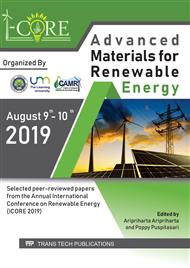[1]
N. Kawee, N. T. Lam, and P. Sukyai, Homogenous isolation of individualized bacterial nanofibrillated cellulose by high pressure homogenization,, Carbohydr. Polym., vol. 179, p.394–401, (2018).
DOI: 10.1016/j.carbpol.2017.09.101
Google Scholar
[2]
H. Yan et al., Synthesis of bacterial cellulose and bacterial cellulose nanocrystals for their applications in the stabilization of olive oil pickering emulsion,, Food Hydrocoll., vol. 72, p.127–135, (2017).
DOI: 10.1016/j.foodhyd.2017.05.044
Google Scholar
[3]
M. H. Deinema and L. P. T. M. Zevenhuizen, Formation of cellulose fibrils by gram-negative bacteria and their role in bacterial flocculation," Arch. f?,r Mikrobiol., vol. 78, no. 1, p.42–57, (1971).
DOI: 10.1007/bf00409087
Google Scholar
[4]
S. Yamanaka, M. Ishihara, and J. Sugiyama, Structural modification of bacterial cellulose,, Cellulose, vol. 7, p.213–225, (2000).
Google Scholar
[5]
H. C. Huang, L. C. Chen, S. Bin Lin, C. P. Hsu, and H. H. Chen, In situ modification of bacterial cellulose network structure by adding interfering substances during fermentation,, Bioresour. Technol., vol. 101, no. 15, p.6084–6091, (2010).
DOI: 10.1016/j.biortech.2010.03.031
Google Scholar
[6]
B. A. McKenna, D. Mikkelsen, J. B. Wehr, M. J. Gidley, and N. W. Menzies, Mechanical and structural properties of native and alkali-treated bacterial cellulose produced by Gluconacetobacter xylinus strain ATCC 53524,, Cellulose, vol. 16, no. 6, p.1047–1055, (2009).
DOI: 10.1007/s10570-009-9340-y
Google Scholar
[7]
S. Gea et al., Bioresource Technology Investigation into the structural, morphological, mechanical and thermal behaviour of bacterial cellulose after a two-step purification process,, Bioresour. Technol., vol. 102, no. 19, p.9105–9110, (2011).
DOI: 10.1016/j.biortech.2011.04.077
Google Scholar
[8]
Y. Liu and H. Hu, X-ray diffraction study of bamboo fibers treated with NaOH,, Fibers Polym., vol. 9, no. 6, p.735–739, (2008).
DOI: 10.1007/s12221-008-0115-0
Google Scholar
[9]
A. Retegi et al., Bacterial cellulose films with controlled microstructure-mechanical property relationships,, Cellulose, vol. 17, no. 3, p.661–669, (2010).
DOI: 10.1007/s10570-009-9389-7
Google Scholar
[10]
H. Suryanto, E. Marsyahyo, Y. S. Irawan, and R. Soenoko, Morphology, Structure, and Mechanical Properties of Natural Cellulose Fiber from Mendong Grass (Fimbristylis globulosa),, J. Nat. Fibers, vol. 11, no. 4, p.333–351, Jul. (2014).
DOI: 10.1080/15440478.2013.879087
Google Scholar
[11]
A. Mittal, R. Katahira, M. E. Himmel, and D. K. Johnson, Effects of alkaline or liquid-ammonia treatment on crystalline cellulose: changes in crystalline structure and effects on enzymatic digestibility,, Biotechnol. Biofuels, vol. 4, no. 1, p.41, Oct. (2011).
DOI: 10.1186/1754-6834-4-41
Google Scholar
[12]
H. Suryanto, Y. S. Irawan, E. Marsyahyo, and R. Soenoko, Effect of Alkali Treatment on Crystalline Structure of Cellulose Fiber From Mendong (Fimbristylis globulosa) Straw,, Key Eng. Mater., vol. 594–595, p.720–724, (2014).
DOI: 10.4028/www.scientific.net/kem.594-595.720
Google Scholar
[13]
J. Gong, J. Li, J. Xu, Z. Xiang, and L. Mo, Research on cellulose nanocrystals produced from cellulose sources with various polymorphs,, RSC Adv., vol. 7, no. 53, p.33486–33493, (2017).
DOI: 10.1039/c7ra06222b
Google Scholar
[14]
N. Halib, C. Iqbal, M. Amin, and I. Ahmad, Physicochemical Properties and Characterization of Nata de Coco from Local Food Industries as a Source of Cellulose,, Sains Malaysiana, vol. 41, no. 2, p.205–211, (2012).
Google Scholar
[15]
M. A. Moharram and O. M. Mahmoud, FTIR spectroscopic study of the effect of microwave heating on the transformation of cellulose I into cellulose II during mercerization,, J. Appl. Polym. Sci., vol. 107, no. 1, p.30–36, (2008).
DOI: 10.1002/app.26748
Google Scholar
[16]
C. J. Knill and J. F. Kennedy, Degradation of cellulose under alkaline conditions,, Carbohydr. Polym., vol. 51, no. 3, p.281–300, Feb. (2002).
Google Scholar


